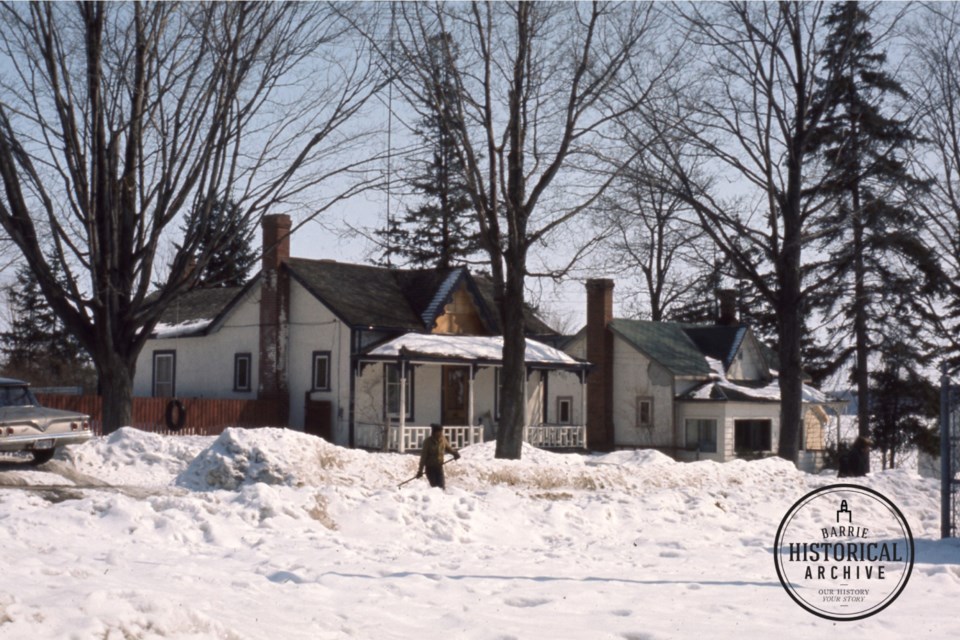This ongoing series from Barrie Historical Archive curator Deb Exel shows old photos from the collection and one from the present day, as well as the story behind them.
11 Nelson Sq. – Rose Cottage
Nelson Square, both East and West, and Nelson Street were named for the hero of the Battle of Trafalgar, British Admiral Horatio Nelson.
Nelson had a long and impressive naval career. His victories during the French Revolutionary and Napoleonic Wars contributed to his reputation as one of the greatest naval commanders in history.
Nelson Square is bounded by Blake Street to the north, Kempenfelt Drive to the south, Nelson Square West and Nelson Square East.
On this pretty park area sits the old East Ward School, built as a two-room schoolhouse in 1876. It was designed by A. Clifford Thompson, a civil engineer and land surveyor known for his collaboration with another engineer/surveyor, Maurice Gaviller, on buildings such as Judge Ardagh’s home, ‘The Hill’ on Theresa Street, the rehab of the Barrie Fire Hall at Collier and Mulcaster streets, and the Ardagh Memorial Home, which opened in 1873 at the corner of Dundonald and Louisa streets (an extension of Dunlop Street East) to house, feed, clothe and assist women and children.
Following the Prince of Wales' visit to Barrie, the East Ward School was renamed King George School. By 1948, plans were made to replace King George School with Codrington Street School, and in 1951, the old East Ward School was closed, reopening in 1953 as a school for special needs with seven students. It is currently the Parkview Centre for seniors.
On the east side of the square are two charming cottages – 13 and 11 Nelson Sq. The land they stand on was transferred from the Crown to George Anthony Barber in 1844.
In the early 1880s, the Outrams were living in the little house at 11 Nelson Sq. E. Mrs. Outram was born Frances Simmons in England in about 1837, marrying George Outram in 1868. By 1896, she was widowed and living alone in the little cottage, supporting herself by working for the Public School Board, replacing the retired caretaker of the East Ward School in 1886. Mrs. Outram passed away at home in 1911.
Families came and went from the little house, described as ‘plastered with lime mortar.' In 1920, Harold Woolard, born about 1888 in England and coming to Canada in 1912, lived there with his wife Susan and their four girls: Gwendolyn, Eileen, Peggy and Gladys. Although Harold, according to 1921 records, could neither read nor write – skills we take for granted these days – he supported his large family as a weighmaster.
In 1933, Fred Morren, a sub-collector with Customs and Excise, son of the late Barrie veterinarian Dr. A. Morren, married Miriam Burgess of Bedford Hall, London, England, in a lovely morning wedding at Trinity Anglican Church. Following a honeymoon, the young couple resided at their home, Rose Cottage, at 11 Nelson Sq. E.
Unfortunately, the newlyweds never got to meet ‘Bella’ Ball… who had lived next door neighbour at 13 Nelson Sq. E. My colleague Mary Harris adds that “George Ball, a native of County Fermanagh, Ireland, was born in 1801 and ventured to Canada in 1828, arriving in the Village of Kempenfeldt six years later. Mr. Ball farmed and regularly floated logs from Kempenfeldt to Lally’s sawmill at Tollendal. In 1847, Ball married Frances Gallagher, and the two raised a family of five boys and five girls. One of the last of this family was Miss Margaret Isabella Ball, who lived in this house until her death in 1930 at age 80.”



